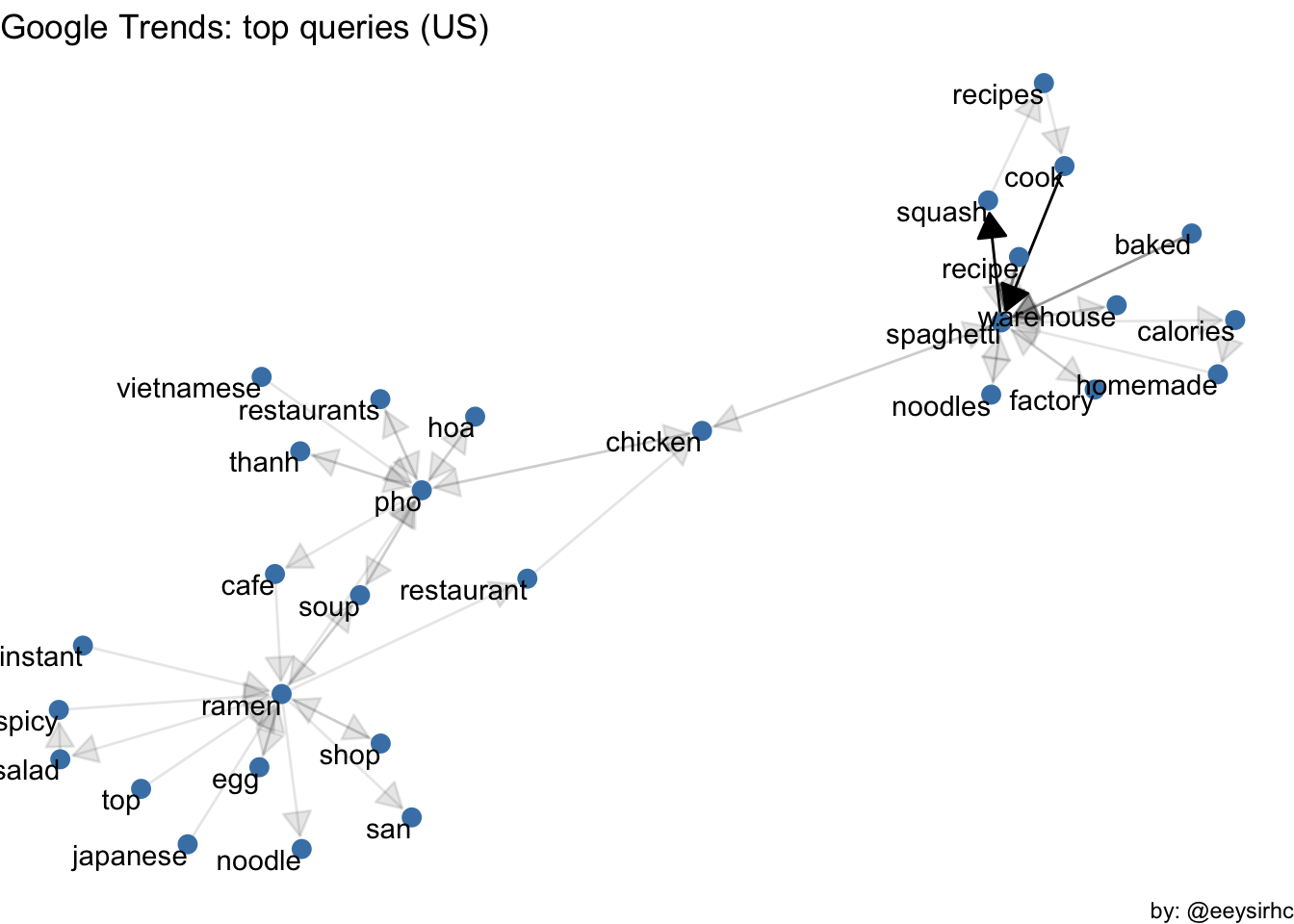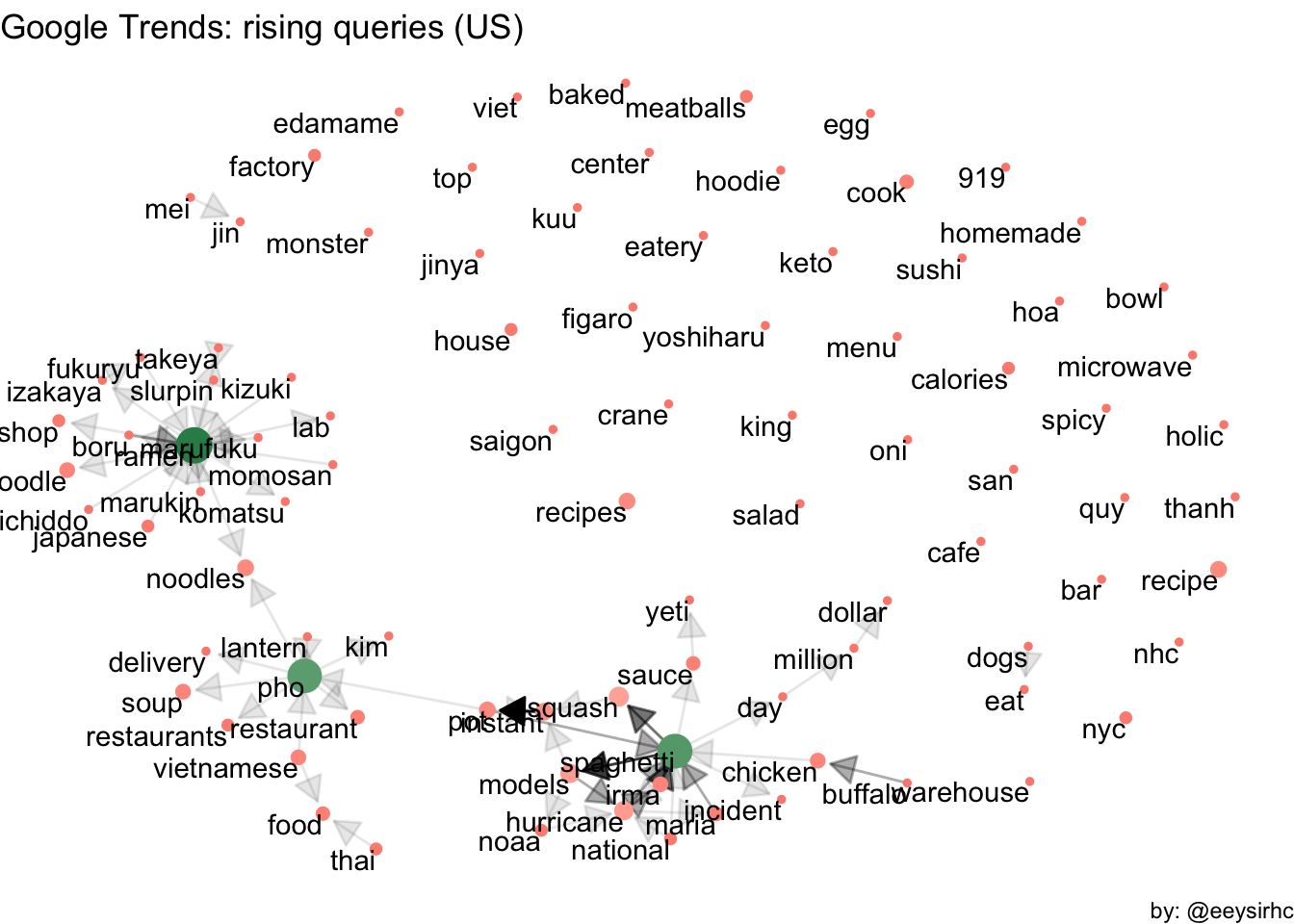Google Trends is great for understanding relative search popularity for a given keyword or phrase. However, if we wanted to explore the topics some more it is quite clunky to retrieve that data within the web interface.
Enter the gtrendsR package for #rstats and what better way to demonstrate how this works than by pulling search popularity for ramen, pho, and spaghetti (hot on the heels of my last article about ramen ratings)!
Load packages
library(tidyverse)
library(lubridate)
library(gtrendsR)Extract Google Trends data
Maximum of five keywords at a time and let’s focus only on US search interest.
food <- gtrends(c("ramen", "pho", "spaghetti"),
geo = c("US"))Clean up our dataframe
food_timeseries <- as_tibble(food$interest_over_time) %>%
mutate(date = ymd(date)) %>% # CONVERT DATE FORMAT
filter(date < Sys.Date() - 7) # REMOVE "NOISY" DATA FROM LAST SEVEN DAYSQuick peek at data
food_timeseries## # A tibble: 780 x 7
## date hits keyword geo time gprop category
## <date> <int> <chr> <chr> <chr> <chr> <int>
## 1 2016-02-07 15 ramen US today+5-y web 0
## 2 2016-02-14 16 ramen US today+5-y web 0
## 3 2016-02-21 16 ramen US today+5-y web 0
## 4 2016-02-28 16 ramen US today+5-y web 0
## 5 2016-03-06 16 ramen US today+5-y web 0
## 6 2016-03-13 15 ramen US today+5-y web 0
## 7 2016-03-20 17 ramen US today+5-y web 0
## 8 2016-03-27 16 ramen US today+5-y web 0
## 9 2016-04-03 17 ramen US today+5-y web 0
## 10 2016-04-10 17 ramen US today+5-y web 0
## # … with 770 more rowsGraph interest over time
food_timeseries %>%
ggplot() +
geom_line(aes(date, hits, color = keyword), size = 1) +
scale_y_continuous(limits = c(0, 100)) +
scale_color_brewer(palette = 'Set2') +
theme_bw() +
labs(x = NULL,
y = "Relative Search Interest",
color = NULL,
title = "Google Trends: interest over time (US)") 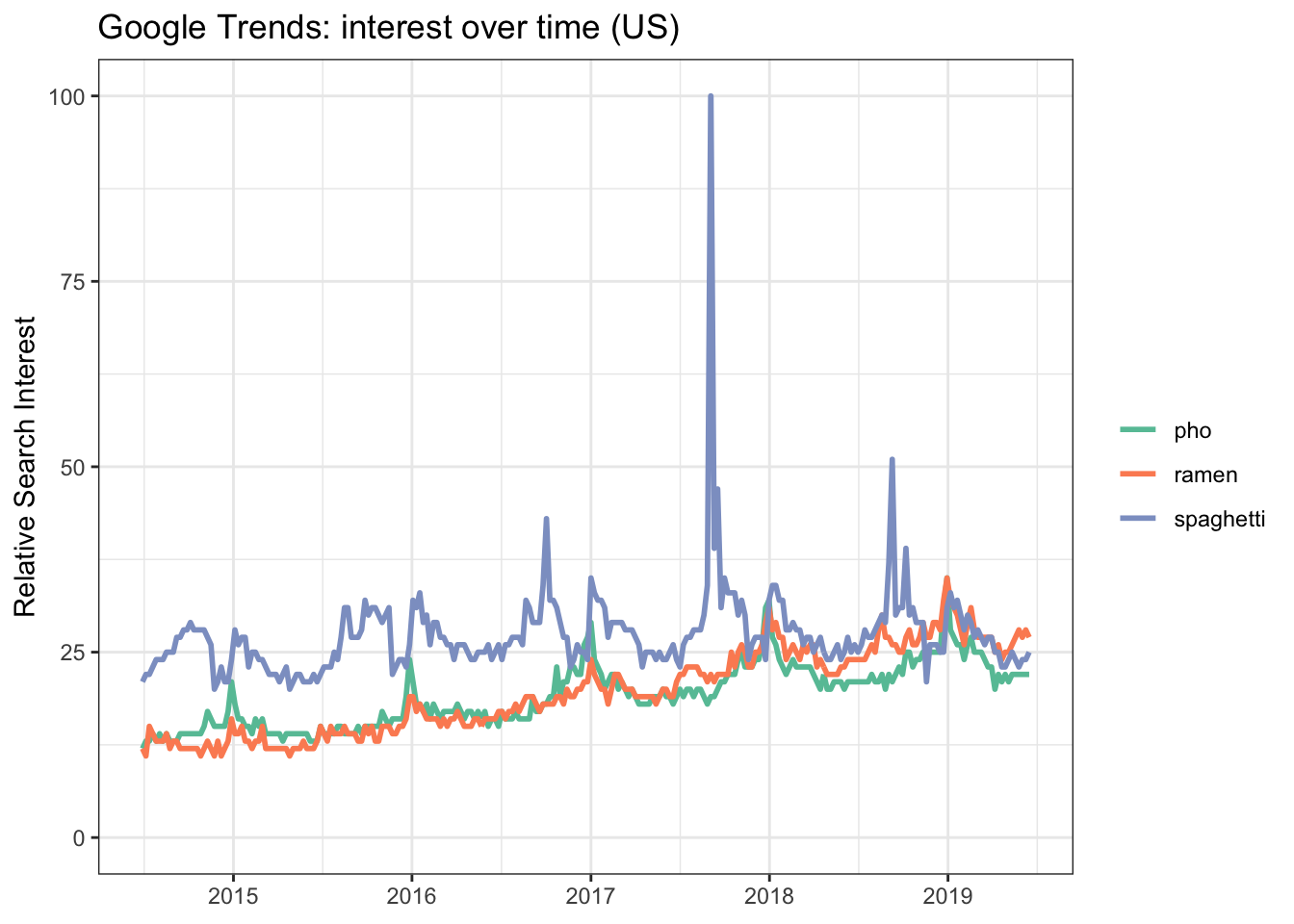
It looks like ramen has picked up traction over the last five years and even surpassed spaghetti popularity earlier this year.
I wonder what that will look like a year from now? We’ll look to using the prophet package from Facebook to forecast future popularity.
Forecasting relative search popularity
Load packages
library(prophet)Prepare the data
Let’s see how we do for ramen search popularity.
ramen_timeseries <- food_timeseries %>%
filter(keyword == 'ramen') %>%
select(date, hits) %>%
mutate(date = ymd(date)) %>%
rename(ds = date, y = hits) %>% # CONVERT COLUMN HEADERS FOR PROPHET
arrange(ds) # ARRANGE BY DATEBuild the model
ramen_m <- prophet(ramen_timeseries)
ramen_future <- make_future_dataframe(ramen_m, periods = 365) # PREDICT 365 DAYS
ramen_ftdata <- as_tibble(predict(ramen_m, ramen_future))Combine forecast with actuals
ramen_forecast <- ramen_ftdata %>%
mutate(ds = ymd(ds),
segment = case_when(ds > Sys.Date()-7 ~ 'forecast',
TRUE ~ 'actual'), # SEGMENT ACTUAL VS FORECAST DATA
keyword = paste0("ramen")) %>%
select(ds, segment, yhat_lower, yhat, yhat_upper, keyword) %>%
left_join(ramen_timeseries) # JOIN ACTUAL DATAPlot forecasting results
ramen_forecast %>%
rename(date = ds,
actual = y) %>%
ggplot() +
geom_line(aes(date, actual)) + # PLOT ACTUALS DATA
geom_point(data = subset(ramen_forecast, segment == 'forecast'),
aes(ds, yhat), color = 'salmon', size = 0.1) + # PLOT PREDICTION DATA
geom_ribbon(data = subset(ramen_forecast, segment == 'forecast'),
aes(ds, ymin = yhat_lower, ymax = yhat_upper),
fill = 'salmon', alpha = 0.3) + # SHADE PREDICTION DATA REGION
scale_y_continuous(limits = c(0,100)) +
theme_bw() +
labs(x = NULL, y = "Relative Search Interest",
title = "Google Trends: interest over time for \"ramen\" (US)")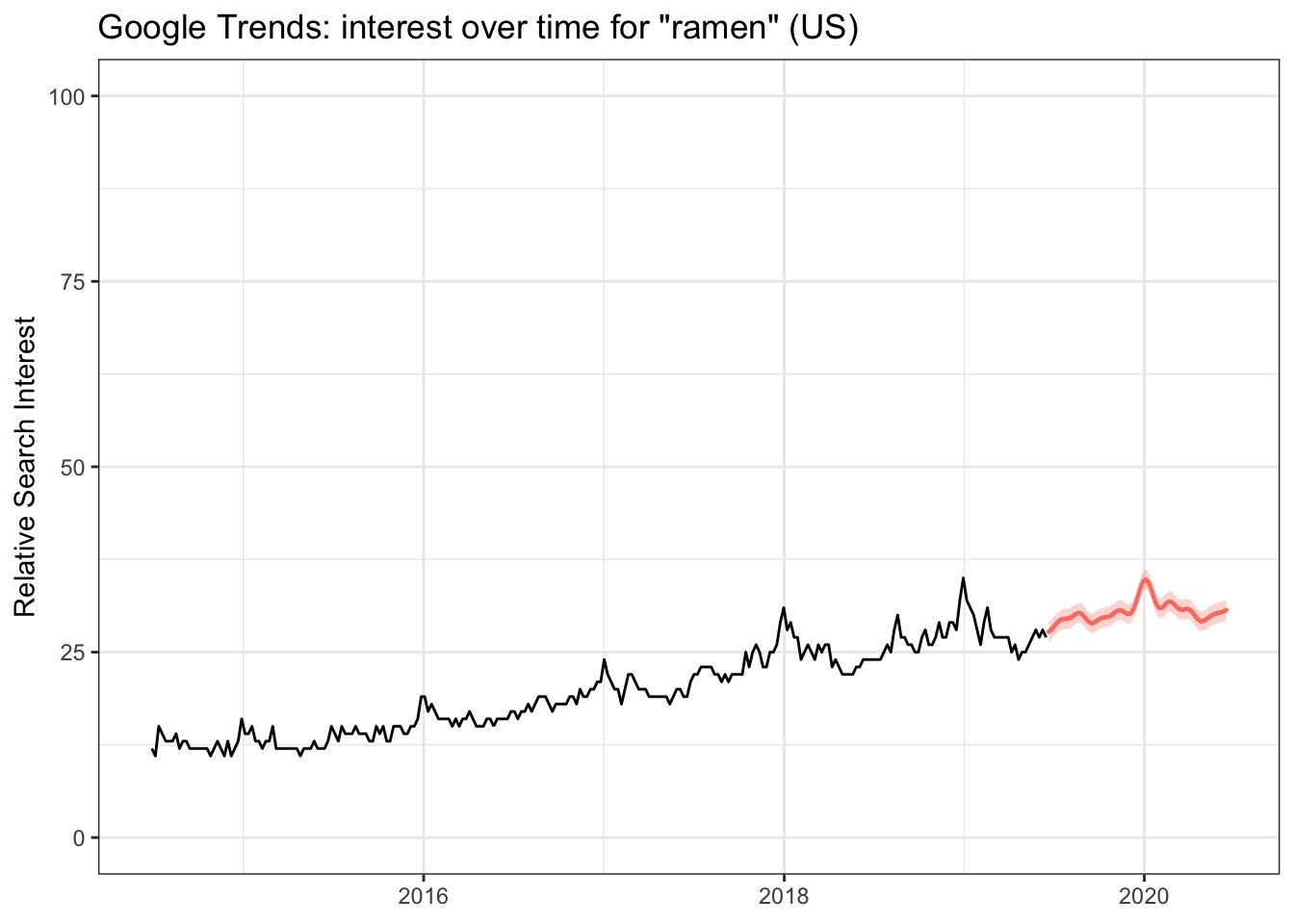
The chart above doesn’t look too bad however this is relative search popularity so we need to compare the prediction with pho and spaghetti as well.
# FUTURE NOTE: REFACTOR FOR DRY PRINCIPLES
# BUILD FORECASTING MODEL FOR PHO
pho_timeseries <- food_timeseries %>%
filter(keyword == 'pho') %>%
select(date, hits) %>%
mutate(date = ymd(date)) %>%
rename(ds = date, y = hits) %>%
arrange(ds)
pho_m <- prophet(pho_timeseries)
pho_future <- make_future_dataframe(pho_m, periods = 365)
pho_ftdata <- as_tibble(predict(pho_m, pho_future))
pho_forecast <- pho_ftdata %>%
mutate(ds = ymd(ds),
segment = case_when(ds > Sys.Date()-7 ~ 'forecast',
TRUE ~ 'actual'),
keyword = paste0("pho")) %>%
select(ds, segment, yhat_lower, yhat, yhat_upper, keyword) %>%
left_join(pho_timeseries)
# BUILD FORECASTING MODEL FOR SPAGHETTI
spaghetti_timeseries <- food_timeseries %>%
filter(keyword == 'spaghetti') %>%
select(date, hits) %>%
mutate(date = ymd(date)) %>%
rename(ds = date, y = hits) %>%
arrange(ds)
spaghetti_m <- prophet(spaghetti_timeseries)
spaghetti_future <- make_future_dataframe(spaghetti_m, periods = 365)
spaghetti_ftdata <- as_tibble(predict(spaghetti_m, spaghetti_future))
spaghetti_forecast <- spaghetti_ftdata %>%
mutate(ds = ymd(ds),
segment = case_when(ds > Sys.Date()-7 ~ 'forecast',
TRUE ~ 'actual'),
keyword = paste0("spaghetti")) %>%
select(ds, segment, yhat_lower, yhat, yhat_upper, keyword) %>%
left_join(spaghetti_timeseries)
# COMBINE ALL MODELS
keyword_forecast <- rbind(ramen_forecast, pho_forecast, spaghetti_forecast) %>%
rename(date = ds, actual = y)Final plot
keyword_forecast %>%
ggplot() +
geom_line(aes(date, actual, color = keyword), size = 1) +
geom_ribbon(data = subset(keyword_forecast, segment == 'forecast'),
aes(date, ymin = yhat_lower, ymax = yhat_upper, fill = keyword),
alpha = 0.3) +
geom_point(data = subset(keyword_forecast, segment == 'forecast'),
aes(date, yhat, color = keyword), size = 0.1) +
scale_y_continuous(limits = c(0,100)) +
scale_color_brewer(palette = 'Set2') +
scale_fill_brewer(palette = 'Set2') +
theme_bw() +
labs(x = NULL, y = "Relative Search Interest",
title = "Google Trends: interest over time (US)") 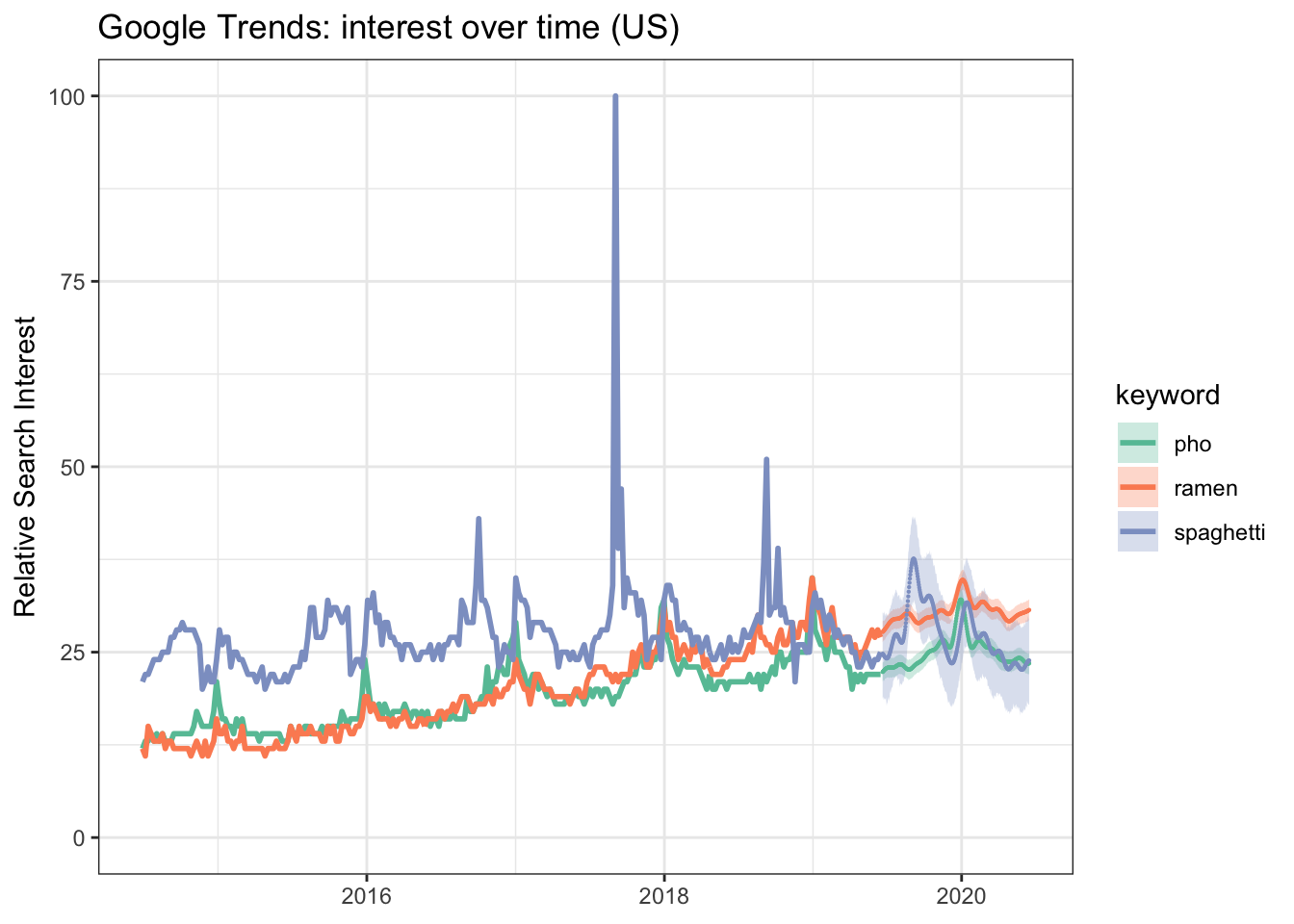
One year from now we should expect to see ramen at the top followed by pho and spaghetti fighting for a close second in terms of relative search interest.
Wrapping up
You will find a million methods on how to download Google Trends data.
This is just one way to do it in R where we pulled the data, plotted historical trends, forecasted future search popularity, and even performed some light text mining to find relationship between words.
